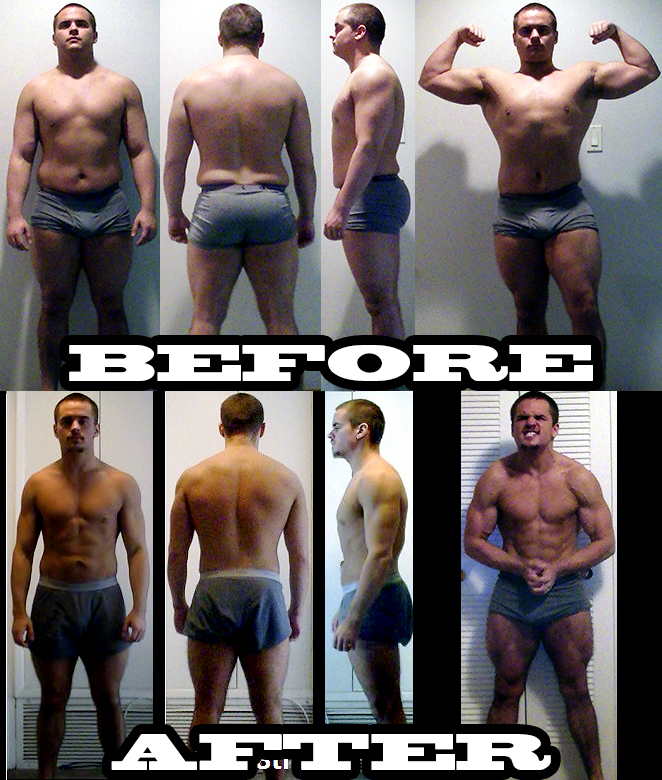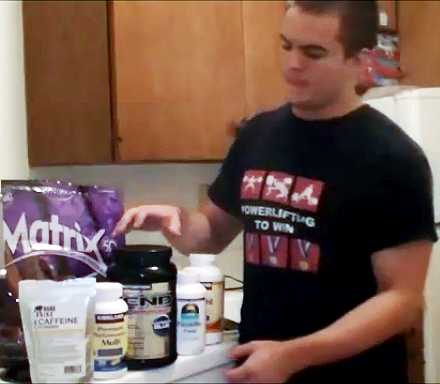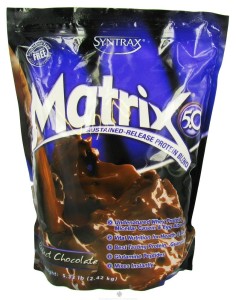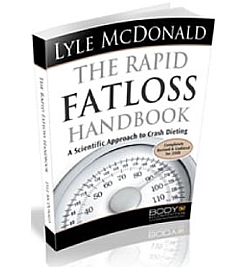For those who don’t know, Lyle McDonald is one of the original online nutrition gurus. The guy was there arguing the science from day one on UseNet. Lyle has authored multiple nutrition books including the incredibly popular Ketogenic Diet. He is also the author of www.bodyrecomposition.com which is quite literally one of the best nutritional resources on the entire internet.
More than anything else, Lyle is a science nerd; he is a science junkie. Virtually NOTHING that comes from Lyle is without rigorous scientific backing (he makes it clear when he is opining). Just for example, the Ketogenic Diet had over 600 references.
The guy knows his shit. His longevity in the nutrition game is proof-positive that he gets results for people who follow his methods.
If you’d rather watch than listen:
The Rapid Fatloss Handbook Diet
Fortunately for me, I’ve been following Lyle and his work for long as I have been lifting weights. When I decided to drop two full weight classes in less than three months, I knew my diet of choice would Lyle’s Rapid Fatloss Handbook (RFL).

In short, RFL is simply a diet where you eat lean proteins and not much else; ergo, it is a “protein-sparring” fast. Now, where Lyle’s expertise enters the picture, and where it makes a world of difference, is in “modifying” this diet for further health optimization, performance maintenance, and FAR greater rates of compliance.
RFL Context
Now, unlike some of Lyle’s other works, RFL is not a massive scientific manual that describes this entire process in excruciating detail. In fact, RFL is a simple booklet that can be absorbed fully in one sitting.
And, just to be clear, RFL is not aimed explicitly at performance athletes although they are addressed in several instances. RFL is intended to be read by any lay person. Lyle will literally walk you through each and every step of setting up the diet to ensure that you get all the details correctly.
Here is the table of contents:
Introduction
Chapter 1: Just how quickly?
Chapter 2: When is a crash diet appropriate?
Chapter 3: Basic nutrition overview
Chapter 4: Nutrient Metabolism Overview
Chapter 5: An Overview of the Diet
Chapter 6: Estimating body fat percentage
Chapter 7: Exercise
Chapter 8: Setting up the diet
Chapter 9: Metabolic slowdown and what to do about it
Chapter 10: Free meals, refeeds and diet breaks
Chapter 11: Ending the Diet – Introduction
Chapter 12: Moving to Maintenance: Non-counting Method Part 1
Chapter 13: Moving to Maintenance: Non-counting Method Part 2
Chapter 14: Moving to Maintenance: Calculation method
Chapter 15: Back To Dieting
Appendix 1: BMI and Body fat charts
RFL and Powerlifting
I’m not going to rehash the basics of nutrition, metabolism, and the rest of those initial chapters. They’re important and relevant, but most competitive powerlifters are already going to be familiar.
What I do want to talk about is the “modifications” that Lyle suggests to improve the efficacy of a protein-sparring fast.
-
- Protein
First of all, instead of basing protein on body weight, as many of these studies do, Lyle has required protein intakes for specific categories of lifters. The leaner you are, the more protein you need to eat. The exact figures are provided in the book.
-
- Fiber
Fiber, in the form of fibrous vegetables, is considered a free food. If you want to chow down on celery to stay fuller, you’re allowed to do that. Certain vegetables are off limits.
-
- Fish Oil
One of Lyle’s most important modifications is the addition of fish oil and EFAs. Including EPA/DHA on an incredibly restrictive diet such as RFL has too many benefits to list. I’m not exaggerating. On RFL, you’ll take in 10g of fish oil per day. I used Kirkland Brand Fish Oil.
-
- Multivitamins
Again, because your diet is so restricted, you’re going to have a completely crap micronutrient diet profile. You’ll need to supplement with a multivitamin of some sort. I just used a generic Kirkland brand multivitamin. It doesn’t matter where you get your multi.
-
- Refeeds and Free Meals
Unlike the original studies conducted, RFL does not require you to grind away without any relief for months on end. Every single week, depending on your category as a lifter, you’ll get at least one free meal and potentially a carbohydrate refeed as well. The free meals reduce the psychological difficulty of the diet and increase compliance; the carbohydrate refeeds do all kinds of important things for keeping your metabolism in check (I won’t get into the science here).
-
- Diet Breaks and Diet Length
Lyle has VERY specific recommendations for exactly how long you should do a “stint” of RFL. The exact length depends on your category as a lifter. This is one of the most important modifications in helping lifters retain their hard earned muscle mass.
-
- Training Changes
With almost no caloric intake, you’re going to have to cut your volume and frequency way, way down. Additionally, you’re going to take in a small amount of preworkout carbs before your lifting sessions. This will allow you to maintain intensity in the gym thus aiding in the prevention of detraining and muscle loss.
My RFL Results
I’m going to explain EXACTLY how I ran RFL, but first let me convince you of its efficacy:

Dates: Jan 1st, 2014 to Mar 18th, 2014 (10 weeks)
Body Composition:
Bodyweight: 200lbs to 169lbs
Waist: 37.25” to 33”
Neck: 17.25” to 16.25”
BF%: ~21.1% to ~14.5%
LBM: ~157lbs to ~146lbs (keep in mind ~5-7lbs of water loss)
Lifts:
Squat: ~405 to 429
Bench: ~250 to 242
Deadlift: ~455 to 452
Total: ~1100 to 1124
So, as you can see, RFL accomplished the objective and accomplished it effectively. I dropped two full weight classes without losing strength.
EXACTLY How I Ran RFL
Daily Eating/Supplementation
Four times per day, I drank a shake consisting of:
2 scoops Syntrax Matrix 5.0 Perfect Chocolate Whey Protein Powder
1 teaspoon Source Naturals Psyllium Husk Powder, ~5g (Soluble Fiber Supplement)
2 Kirkland Brand Fish Oil pills
1 Kirkland Brand Multivitamin(twice per day)
Meal Macros: 46g Protein, 11g Carbs, 6g fat, 7g fiber*
Daily Macros: 184g Protein, 44g Carbs, 24g fat, 28g fiber*
*The carb numbers include the fiber
I want to make it explicitly clear that Lyle recommends a whole foods approach to RFL. However, that is not what I did. In order to save myself a lot of time cooking chicken and vegetables, I decided to opt for a liquid diet on my run of RFL.
Training
Due to the extremely restricted diet, I trained only twice per week using a basic 5×5 scheme:
Monday:
Bench Press:
Set #1: 5 reps at 50% of Top Set
Set #2: 5 reps at 62.5% of Top Set
Set #3: 5 reps at 75% of Top Set
Set #4: 5 reps at 87.5% of Top Set
Set #5: 5 reps at Top Set
Squat:
Set #1: 5 reps at 50% of Top Set
Set #2: 5 reps at 62.5% of Top Set
Set #3: 5 reps at 75% of Top Set
Set #4: 5 reps at 87.5% of Top Set
Set #5: 5 reps at Top Set
BW Chinups: 3 sets, max reps
Friday:
Bench Press:
Set #1: 5 reps at 50% of Top Set
Set #2: 5 reps at 62.5% of Top Set
Set #3: 5 reps at 75% of Top Set
Set #4: 5 reps at 87.5% of Top Set
Set #5: 5 reps at Top Set
Deadlift:
Set #1: 5 reps at 50% of Top Set
Set #2: 5 reps at 62.5% of Top Set
Set #3: 5 reps at 75% of Top Set
Set #4: 5 reps at 87.5% of Top Set
Set #5: 5 reps at Top Set
BW Chinups: 3 sets, max reps
Preworkout Nutrition
25g Gatorade Powder (Easy Carb Source)
10g Scivation Xtend (Brainched-Chain Amino Acids /w Electrolyes)
400mg Caffeine Powder, I used Hard Rhino on Amazon

This was my full RFL supplement stack: Syntrax Matrix 5.0, Source Naturals Psyllium Husk, Kirkland Brand Fish Oil and Multivitamin, Hard Rhino Caffeine Powder and Scivation Xtend BCAAs.
The preworkout carbs allow you to train much more intensely than you can with zero glycogen in your system. The preworkout caffeine supplement is a huge deal in my opinion because energy levels tend to dip HARD on RFL. That is the nature of a sub ~1000kcal diet. I also used BCAAs with electrolytes because, without a balanced diet, you generally don’t get enough of either. Again, this keeps training intensity higher which helps prevent detraining and thus muscle loss.
Post Workout Nutrition
Because of my diet category as a lifter, I got one free meal per week and one refeed per week. I ALWAYS used these post-workout on Monday and Friday. I honestly feel like this is a key adjustment to make. Though nutrient timing isn’t generally that important in a more balanced diet, on RFL, I think selectively providing that influx of carbs and other nutrients post-workout can go a long ways towards muscle mass maintenance. It certainly worked well for me.
Moving Forward
All in all, RFL is an extremely tough diet for most people to adhere. That said, when it comes right down to it, RFL is literally the single fastest way to lose weight without significant muscle loss. I generally strongly recommend against extreme approaches, but sometimes they are appropriate or even necessary.
Again, to be 100% clear, I do not recommend extreme dieting approaches for maximal performance in powerlifting, but if you’re working against a deadline, you might not have any other choice.
That said, if you find yourself in a position where you need to crash diet, perhaps to make weight, definitely consider RFL. In my opinion, it is your best chance at dropping the weight quickly without losing too much from your performance. You can pick up a copy here.
Beyond that, I highly recommend that you check out BodyRecomposition.com. Lyle is one of the smartest guys in the nutrition game, period. His free content is gold and I find myself referencing many of the articles time and time again. If you haven’t already, do yourself a favor and make sure you peek around his website.
If you decide you want to do RFL, and you need help for whatever reason, I will answer any and all questions you have to the best of my ability. RFL is something I have quite a bit of experience with and I’d be more than glad to make sure your experience is as pleasant as possible. If you do it wrong, RFL can really, really suck.
Have a nice day.
Like this Article? Subscribe to our Newsletter!
If you liked this articled, and you want instant updates whenever we put out new content, including exclusive subscriber articles and videos, sign up to our Newsletter!
Questions? Comments?
For all business and personal coaching services related inqueries, please contact me:


As you know, Tom, I did the RFL diet last Fall for eight weeks. The results were incredible based on previous diet experiences, my age (59), and my history of low metabolism and low thyroid. I lost 15 pounds in 8 weeks as compared to losing 8 lbs in 8 weeks on the 20/20 program and other extreme weight loss diets.
However, the thing that impressed me more, is that I didn’t go into “raging cravings” mode when I finished the diet nor did I gain the weight back. In fact, after six months of over-eating, I only gained 7 lbs back. I also didn’t look like I had been starving (gaunt, weak, etc) during or after the diet.
This diet put me in a good position to start and sustain a more realistic diet for long-term health and slower weight loss. Thanks for recommending it to me.
Thanks for sharing your experience, Mom! I’m glad it worked out so well for you.
Thanks for the video and explanation, I read and watched both.
I’m thinking about doing this diet as I have try-outs, I’ve read parts of the book and will be reading it fully before deciding whether to be done on Saturday or not. My problem is that I can train from 5-7 hours on one of the days, so I’d probably burn everything I’ve eaten, I was considering replacing the 5-10g carbs or whatever it is for something a bit larger as I’d need the energy. Do you think this would be a good idea adapting it to myself?
What sport are you considering using RFL for? I’d definitely make sure that you have your refeed (depending on diet classification) before that 5-7 hour training day. If that’s not possible, I’d bring something ~100 grams of carbs in the form gatorade and consume it intermittently throughout the training.
I appreciate the fast reply and will take your Gatorade into addition of the diet. Probably laughed at, but Cheerleading. However, I’m constantly tumbling during that 5-7 hours which I’ll need to work on especially with try-outs coming up soon. The day I’d be doing that is a Wednesday, early into Thursday morning.
I had a good friend who helped pay for college with a cheerleading scholarship so no judgment here : ). The only thing I’d ask is are you absolutely sure that RFL is appropriate here? I’m admittedly ignorant, but I don’t think there are weight classes in cheer leading. Isn’t your performance going to be far more important than body fat %? I don’t think RFL is a great diet to use while participating in a performance sport.
Question: you mentioned you would be taking 10g of fish oil a day first, and then after you said “2 kirkland brand fish oil pills.” Those are 1000mg each. Which did you do?
Also I’m assuming this is the 2nd edition of the book? Additionally, why did you leave out the EC stack?
I took 10g per day. I took 2-3 pills per meal. Sorry, I didn’t make that very clear.
Yes, this is the 2nd edition of the book. Ephedrine cannot be purchased over the counter in the U.S. I didn’t feel like going through the trouble of getting it. I also generally get very bad insomnia when I use stimulants too frequently. I think EC is a great stack and a useful addition to RFL. I just personally felt the costs outweighed the benefits.
I think that’s… a lot. I was told by someone it was 6g a day? Did you change that?
Yes I did. Lyle recommends 6g per day for the diet.
did you do any cardio during the diet ?
Nope.